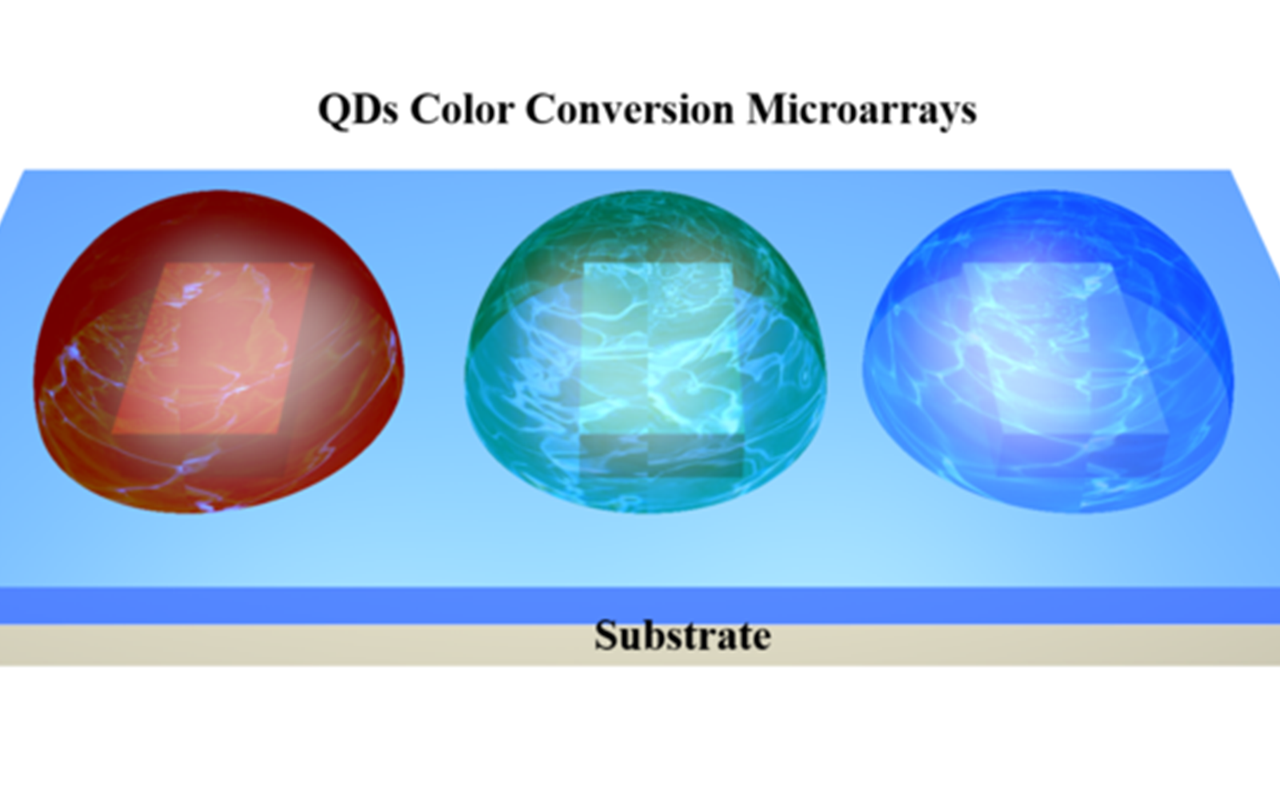SSL | Quantum Dots
|
Jun 15, 2022
Newly Developed Technique to Improve Quantum Dots Color Conversion Performance
Quantum dots color conversion (QDCC) has become a foundational technology in the design of full-color light-emitting devices with dramatically improved color performance. However, conventional QDCC pixels fabricated by inkjet printing, that is commonly used, are still too thin to achieve efficient color conversion. A research team has developed perovskite quantum dots microarrays with strong potential for QDCC applications, including photonics integration, micro-LEDs, and near-field displays.
The team published their findings on May 31, 2022 in Nano Research.(DOI 10.1007/s12274-022-4466-4)
In printing, QDCC is considered a versatile way to achieve full-color organic light-emitting diodes and micro-light-emitting diodes displays. QDCC provides a wide range of color performance and easy integration. However, the conventional combination of quantum dots and coffee-ring effects or puddle of particle-laden liquid that occur after evaporation, lowers the light conversion efficiency and emission uniformity in quantum dot microarrays. This also contributes to blue-light leakage or optical crosstalk, where unwanted coupling occurs between signal paths.
Perovskite quantum dots (PQDs) hold potential as an attractive material and can resolve some of the problems found in conventional QDCC. PQDs are made from the mineral perovskite. While perovskite quantum dots are relatively new, they have already been shown to have attractive properties that make them extremely suited for electronic and optoelectronic applications. By using patterned black photoresist molds to make the QDs pixels, researchers have been able to increase the pixel thickness and avoid the optical crosstalk, a common but significant issue which prevents better printing results. But the manufacturing costs increased substantially. The research team set out to resolve these challenges by developing a method that creates PQDs with a robust 3D structure.
“To solve these problems, we fabricated 3D perovskite quantum dots microarrays by combining the inkjet printing and in-situ fabrication of perovskite quantum dots during the photopolymerization of precursor ink,” said Gaoling Yang, an assistant professor in the School of Optics and Photonics at Beijing Institute of Technology. Inkjet printing is a widely used deposition method for inorganic and organic optoelectronics. With its non-contact, material-efficient and reproducible processing, it has attracted attention in patterned microarrays. Photopolymerization is a technique that uses light to create a polymer structure. Using the photopolymerization technique, the researchers achieved a perovskite quantum dots color conversion microarray with a pixel size of 20 microns. Their technique provides a new technical route for light conversion applications, such as color conversion micro-LED.
The fabricated PQDs microarrays exhibit characteristics that are desirable for QDCC applications, including 3D morphology with hemisphere shape and strong photoluminescence. These microarrays achieved strong and uniform photoluminescence in large area because of the seamless integration with in situ-fabricated PQDs. The researchers’ technique demonstrated the potential use of the in situ direct print photopolymerization method for fabricating patterned multicolor perovskite quantum dots microarrays with both wide color gamut and high resolution.
The researchers’ results further confirm the realization of high-quality multicolor microarrays through the inject printing approach. Looking ahead, the team sees potential applications for their work. They are confident that this technique paves the way for the further fabrication of full-color QDCC micro-LED displays. “The in situ direct print photopolymerization technique allows for precise control of the pixel structure, removing the aggregation of QDs and coffee-ring effects in microarrays, which will aid in their expansion in photonics integration, full-color display, on-chip biomedical diagnostics, and next-generation augmented reality and virtual reality devices,” said Yang.
The research team includes Xiu Liu, Jianjun Li, and Yuejin Zhao from the School of Optics and Photonics, Beijing Institute of Technology; and Pingping Zhang, Weitong Lu, and Haizheng Zhong from the MIIT Key Laboratory for Low Dimensional Quantum Structure and Devices, School of Materials Sciences & Engineering, Beijing Institute of Technology; and Gaoling Yang who works at both the Beijing Institute of Technology and the MIIT Key Laboratory.
This research was funded by the National Key Research and Development Program of China, the National Natural Science Foundation of China, the National Natural Science Foundation of China, and the Beijing Institute of Technology Fund Program for Young Scholars Research.
The paper is also available on SciOpen (https://www.sciopen.com/article/10.1007/s12274-022-4466-4) by Tsinghua University Press.
News Source: https://www.eurekalert.org/news-releases/955497
© 2022 Luger Research e.U. – Institute for Innovation & Technology

